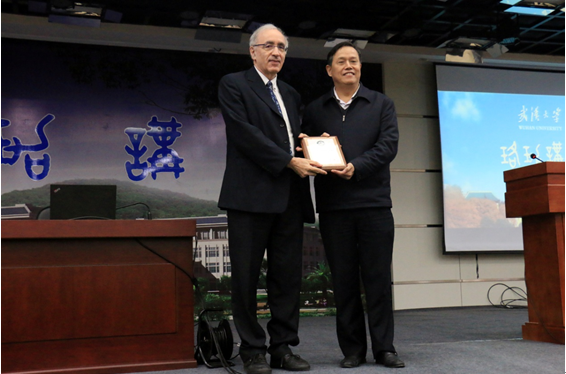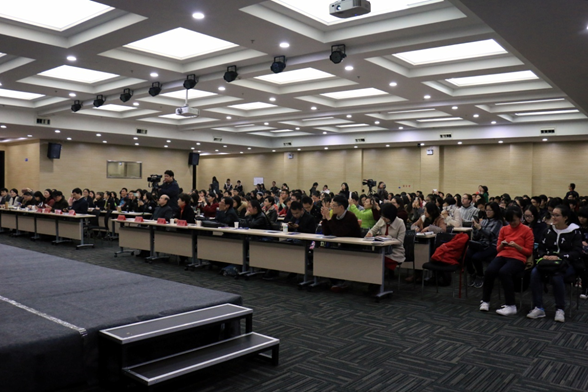When asked to introduce the main characteristics of Confucius to foreigners, what would you say? An educator? The first teacher in China? Or just a man calling for “benevolence, righteousness, politeness, intelligence and trust”? “Maybe none of the answers is suitable.” Joël Bellassen, a famous sinologist commented on these answers at the 151th lecture of Luojia Forum, which was held at the library of Wuhan University on November 11.

Professor Joël Bellassen and Luo Yuting, the Vice-Chair of the WHU Council
Joël Bellassen is a professor at Institut national des langues et civilisations orientales, and the Inspecteur général de chinois of the French national ministry of education. As a “Frenchman with the Chinese label”, he has published many books and articles on Chinese culture and language, which makes him not only a famous sinologist but also a disseminator of Chinese culture.
“I am an observer who studies Chinese from a distance”
The topic of the speech, “problems existing in cultural transmission”, took Chinese culture as an example. In professor Bellassen’s opinion, people speaking different languages have different ways of thinking, which might block off the cultural transmission. Chinese culture transmitters should be aware of the complexity of cross-cultural communication, putting themselves in foreigners’ shoes and avoiding taking what they have already been accustomed to for granted. That is to say, when introducing a culture to foreigners, people should consider the receivers’ background and mindsets. However, it is difficult to consciously keep such a proper perspective in mind when teachers teach Chinese in reality.
Professor Bellassen cited a line of an old Chinese poem to explain the importance of studying Chinese from a distance. “The true face of Lushan is lost to my sight, for it is right in this mountain that I reside.” Lushan to the man is what Chinese culture is to its natives. To introduce the Chinese culture and language to foreigners, one should jump out of the Chinese background and stereotypes, in case he or she may be blocked by the culture itself.

Professor Bellassen giving the speech
However, as a person who studied Chinese for more than 40 years and uses Chinese every day, professor Bellassen has very much been “Chinesized”. Instead of being an observer, he has already become a participant of Chinese culture. Under this circumstance, two factors help him retain a mindset of an observer, enabling him to continue studying Chinese from a different perspective easily. One is philosophy, which keeps reminding people to detach from all manifestations. He majored not only in Chinese but also in philosophy when he was in Université de Paris VIII. The other factor is the differences between Chinese culture and French culture. On one hand, France is more inclined to the idea of logos, in which eloquence is of high importance in its tradition, and logical analysis and logical link are of necessity. On the other hand, China is a country of visual-civilization, putting great importance on handwriting instead of eloquence, and feelings are more valued than logic. With the help of his knowledge in philosophy and his experience in both Chinese and French culture, Professor Bellassen is able to study Chinese as a participant as well as an observer and to identify the problems in cross-cultural communication. “I am not in Lushan, so I have an advantage”, Bellassen said.
Language influences its speakers’ way of thinking
Bellassen believes that language not only can be used as a tool but it can also shape the way one thinks. This argument was validated by a famous experiment carried out by Dan Slobin, a professor of linguistics. To conduct this experiment, Slobin created the “frog-story project”, using a children’s storybook which tells a story in 24 pictures instead of words as its research tool. He asked several 6-year-old children who spoke different languages to read and narrate this story. It turned out that the narratives were relatively similar in content but differing in form across languages. Based on this finding, professor Slobin concluded that languages can influence the way of thinking to some extent.
Professor Bellassen also did this kind of research. He once asked his son, who was in Finland for an international exchange program, to collect the Finnish words meaning “snow”. As a result, he discovered that many completely different words were used to represent snow at different stages. For example, they have separate words for fresh snow, hardening snow, and snow which is going to melt. While in English, there is only one word—snow. All these Finnish words do not come from the same root. In fact, they have no relations to each other at all. The Finnish language has more words for snow than English, French and Chinese, the possible reasons for this is that there is more snow in Northern Europe, so people living there are more sensitive to its various forms. “Can you take a guess, in Finnish’s eyes, is “the fresh snow” and “the snow which is going to melt” the same thing?” Professor Bellassen asked the audience. No matter what the answer is, one thing is for sure—Finnish’s way of distinguishing things (especially snow) is different from what others do. In other words, language influences its speakers’ way of thinking.
This function of language has both advantages and disadvantages. Speakers of a language will have difficulty in understanding other languages’ speakers, which would become barriers for cross-cultural communication. The good thing is learning another language means adopting another way of thinking, which may be beneficial for speakers. For example, Professor Bellassen often recommends French pupils to learn Chinese because in his mind, Chinese favors the brain and intellectual development.
Mistakes made by transmitters of Chinese culture
Culture transmitters’ insistence on their original ways of thinking will only spoil the effect. After listening to hundreds of Chinese classes in both France and other countries, Professor Bellassen found two tendencies in Chinese teaching which may lead to poor outcomes.
One problem is that teachers coming from China tend to emphasize the importance of practice—do it by yourself —as they always say to their students. French people also highly value practical experience but they will not use “do it by yourself” to replace the theoretical analysis of a cultural phenomenon. “When asked about Chinese cuisine culture, a Chinese teacher may talk for only a few minutes and then say that ‘To better understand this question, let’s make dumplings this Sunday’,” Professor Bellassen observed, “This is good, but for those who want to learn the cultural connotation of dumplings, making this food is not so attractive.”

The audience listening to Professor Bellassen’s speech
The other problem is the lack of both empathy and a comprehensive summary. When summarizing the main characteristics of Confucius to foreigners, Chinese may use the expressions like “educator”, “Benevolence, Righteousness, Politeness, Intelligence and Trust—the basic moral standard for people to follow”, and so on. However, Professor Bellassen thinks that these are not good points to emphasize. As far as he is concerned, in cultural transmission, the receiver is more important than the transmitter. The transmitter must consider the receiver’s way of thinking and his background. In European countries, few people think of Confucius as an educator. In their eyes, Confucius is a thinker and philosopher who not only talked about education but also other important philosophical problems. Another answer, “Benevolence, Righteousness, Politeness, Intelligence and Trust” are no doubt the important parts of Confucius’ thoughts, but they are just details, not a summary.
In Professor Bellassen’s mind, the three most important labels of Confucius should be “an important thinker in China”, “the unreligious humanistic moral figure” and “a value cornerstone of the Han cultural circle”. Firstly, Confucius is a great thinker. Belassen compared Confucius with Socrates, another important thinker who lived roughly at around the same time as Confucius but is more familiar to Europeans. Secondly, Belassen admired the moral standards on which Confucius put great importance—“Benevolence, Righteousness, Politeness, Intelligence and Trust”. However, different from valuing the importance of humanity, Europeans always associated morality with religion. To avoid the culture gaps resulting from such stereotypes, the unreligious and humanistic features of what Confucius proposed should be stressed when they are introduced. Finally, the Confucius philosophy considering humanity such as how to live according to the core human values not only has deep roots in Chinese thoughts but also sails across the ocean. It has already become one school of thought, attracting more and more followers day by day.
As a foreigner, Professor Bellassen knows more about the obstacles on the transmission of Chinese culture and language because he observes them from a distance and breaks up the shackles that most Chinese cannot shake off. His speech at this forum was deemed inspirational to the audience. Zhao Shiju, a professor from WHU’s College of Chinese Language and Literature thought highly of this speech. He believed that Professor Bellassen’s speech about essential issues such as the relationship between languages, ways of thinking and the most important points of Chinese culture from a philosopher’s view can provide a possible direction for related study and broaden the horizon of the audience. A post-graduate student of Teaching Chinese as a Foreign Language said she learnt a lot from this speech. “I also made mistakes which have been mentioned by Professor Bellassen while teaching foreigners Chinese. Now I know that I should work towards closing this cultural gap and to think as foreigners do.”
(Photo by Wu Jiamin, Edited by Li Minjia, Wu Siying, Edmund Wai Man Lai & Hu Sijia)